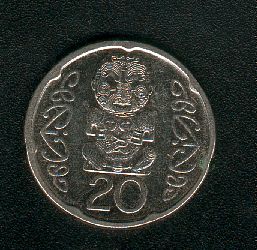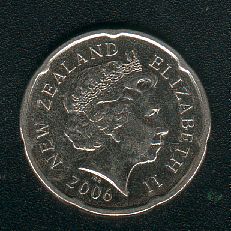Maybe here or in Texas recently, I got what I thought was a Canadian five-cent piece in change. It was nickel-sized and had Queen Elizabeth on it. Nothing too unusual about getting such a coin, even in Texas.
Yesterday I was picking through my change for quarters and took a closer look at the presumed Canadian nickel. It was no such thing. Instead, somehow or other I’d gotten a New Zealand 20-cent piece in change. I’d never seen one before, not even in Australia, where surely some kiwi coins must end up. A coin’s trip from New Zealand to the U.S. isn’t inconceivable, but it sure is unusual.
The Queen, of course, is on the obverse (seen below at 150 percent). Nothing odd in that. (Unless Yuriko sees the coin. That Elizabeth is the sovereign of New Zealand she finds a little strange.)
The reverse, on the other hand, has something no other coin has: Pukaki. My scan hardly does it justice.
 The Reserve Bank of New Zealand says: “New Zealand’s 20 cent coins issued since 1990 feature a remarkable Maori carving, as illustrated above. This is no generic image. Rather it is a reproduction of a specific carving of an 18th century Maori warrior leader called Pukaki, who was a Rangatira (Chief) of the Ngati Whakaue iwi of Te Arawa in the Rotorua district. The carving was made in 1836 and today it can be viewed in the entrance of the Rotorua District Council…
The Reserve Bank of New Zealand says: “New Zealand’s 20 cent coins issued since 1990 feature a remarkable Maori carving, as illustrated above. This is no generic image. Rather it is a reproduction of a specific carving of an 18th century Maori warrior leader called Pukaki, who was a Rangatira (Chief) of the Ngati Whakaue iwi of Te Arawa in the Rotorua district. The carving was made in 1836 and today it can be viewed in the entrance of the Rotorua District Council…
“Pukaki came to the attention of the Reserve Bank as a result of the 1984-87 Te Maori exhibition and the use of Pukaki’s image on a particularly striking Maori Language Commission publicity poster. At the time the Reserve Bank was looking for a new image to put on the 20 cent coin, given that the kiwi was being moved to the new $1 coin. The first Pukaki 20 cent coins were issued in 1990. More recently, a gold $10 collectors’ coin featuring Pukaki has been minted.”
The entire article about Pukaki is here. Also interesting to note: the coin is plated steel, which is more common than I realized, and has even been suggested for U.S. 1 cent and 5 cent coins. (And even though advocated by former Rep. Ron Paul in the same breath he hyperventilated about the boogeyman Fed, it seemed to be a serious proposal.)
The NZ 20c edge is also novel: a treatment called Spanish flower, which is seven indents evenly spaced. Why “Spanish” flower? I wondered. Wiki to the rescue (almost): “The 50 Spanish peseta coin issued between 1990 and 2000 were the first [citation needed] that featured the Spanish flower.” Presumably for benefit of the blind, though it also makes differentiating the coins easier for the sighted.
Anyway, the NZ 20c piece a nice little design. And who knows that the United States minted a 20c piece, once upon a time? Not for long, though. It was one of the great coinage failures of the ’70s. The 1870s, that is.
U.S. Coin Values speculates that “perhaps the coin might have gained a foothold in American society had it not been so easily confused with the quarter of that era.” In other words, it suffered the Susan B. Anthony effect long before that coin ever did.
